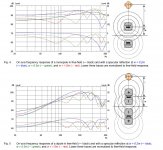That's where I've ended up . . . although the room doesn't have to be unnaturally dead (just not unnaturally "live" 😀). Front wall corners (expecially at the ceiling) are a problem because they become specular (secondary point source) reflectors . . . a bit of diffusion on either of the adjacent walls cures that. Agree also about the "dead" rear wall (and supplementing with "surrounds" when needed, which is almost never), especially if the "dead" extends deep enough to suppress longitudinal room modes.I am also quite close to think that a rather dead room as a whole, but with a fairly reflective front wall is the way to go.
Listening distance ~2.3m, speaker separation ~2m tweeter to tweeter.How far away is your listening position, oh, and how close together are your dipoles?
by "dead" I meant below 0.5s. I guess there is a room volume/RT/SPL relation, like in halls where they calculate the volume per seat. I am no specialist, but it seems to me the more you damp the room, the higher SPL you can cleanly get. I would personaly maybe aim for around 0.3s.
Regarding the rear channels, it's a trick, you definitely don't need it in all recordings but I found that a tiny bit of reverb delayed 70-80ms, coming from the side rear can be a bonus sometimes. It's very subtle, not HT like.
I use it for symphonic works.
Regarding the rear channels, it's a trick, you definitely don't need it in all recordings but I found that a tiny bit of reverb delayed 70-80ms, coming from the side rear can be a bonus sometimes. It's very subtle, not HT like.
I use it for symphonic works.
I don't think I misunderstood anything and I am aware that there is a complex interference pattern and also room modes, but we're talking about a primary strong reflection off the wall at a short distance, which makes it very strong.
Precisely because the monopole backwave is in-phase (while the dipole is 180 out of phase), you have:
- for dipole: you get a first and strongest peak at the 4 x distance_to_wall wavelength (the back wave travels 1/2 wavelength to the wall and back and adds in phase to the front wave)
- for monopole, you get a dip at 4 x distance_to_wall wavelength (the "back" wave travels 1/2 wavelength to the wall and back and adds out of phase to the front wave)
Sure, this is all superimposed to the other peaks and dips of the complex interference pattern plus room modes, but with a strong reflection those first peaks/dips are very dominant.
I don't see why you get less reflection at low frequencies. You probably mean you excite less room modes, which is a different story.
This is the picture off the back wall reflection.The pattern is the same only peaks and dips are shifted. Response is never as in free space. Need equalization.In example at 20hz monopole adds 6db(simulation model) and dipole subtracts 6db
Less reflections from side walls(actually floor and ceiling as well) that's why you excite less room modes. You inject less energy.Sum power response is less with dipole for the same on axis spl(at low frequencies). Less energy in, less reaction out.
Attachments
- Status
- Not open for further replies.
